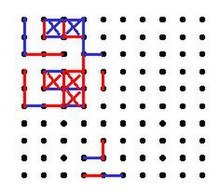
Dots and boxes is a pencil-and-paper game for two players (sometimes more). It was first published in the 19th century by French mathematician Édouard Lucas, who called it la pipopipette.[1] It has gone by many other names,[2] including dots and dashes, game of dots,[3] dot to dot grid,[4] boxes,[5] and pigs in a pen.[6]
The game starts with an empty grid of dots. Usually two players take turns adding a single horizontal or vertical line between two unjoined adjacent dots. A player who completes the fourth side of a 1×1 box earns one point and takes another turn. A point is typically recorded by placing a mark that identifies the player in the box, such as an initial. The game ends when no more lines can be placed. The winner is the player with the most points.[2][7] The board may be of any size grid. When short on time, or to learn the game, a 2×2 board (3×3 dots) is suitable.[8] A 5×5 board, on the other hand, is good for experts.[9]
- ^ Lucas, Édouard (1895), "La Pipopipette: nouveau jeu de combinaisons", L'arithmétique amusante, Paris: Gauthier-Villars et fils, pp. 204–209.
- ^ a b Berlekamp, Elwyn R.; Conway, John H.; Guy, Richard K. (1982), "Chapter 16: Dots-and-Boxes", Winning Ways for your Mathematical Plays, Volume 2: Games in Particular, Academic Press, pp. 507–550.
- ^ Holladay, J. C. (1966), "A note on the game of dots", American Mathematical Monthly, 73 (7): 717–720, doi:10.2307/2313978, JSTOR 2313978, MR 0200068.
- ^ Swain, Heather (2012), Play These Games: 101 Delightful Diversions Using Everyday Items, Penguin, pp. 160–162, ISBN 9781101585030.
- ^ Solomon, Eric (1993), "Boxes: an enclosing game", Games with Pencil and Paper, Dover Publications, Inc., pp. 37–39, ISBN 9780486278728. Reprint of 1973 publication by Thomas Nelson and Sons.
- ^ King, David C. (1999), Civil War Days: Discover the Past with Exciting Projects, Games, Activities, and Recipes, American Kids in History, vol. 4, Wiley, pp. 29–30, ISBN 9780471246121.
- ^ Berlekamp, Elwyn (2000), The Dots-and-Boxes Game: Sophisticated Child's Play, AK Peters, Ltd, ISBN 1-56881-129-2.
- ^ Berlekamp, Conway & Guy (1982), "the 4-box game", pp. 513–514.
- ^ Berlekamp (2000), p. xi: [the 5×5 board] "is big enough to be quite challenging, and yet small enough to keep the game reasonably short".